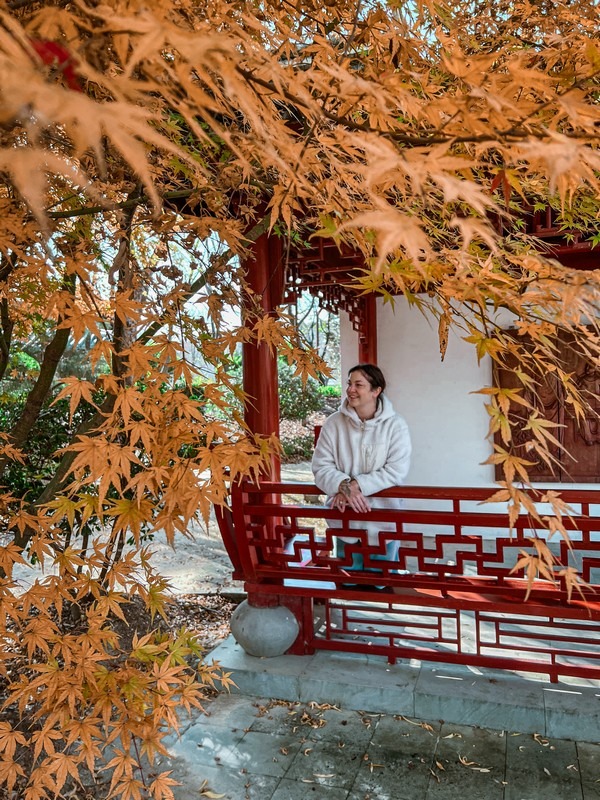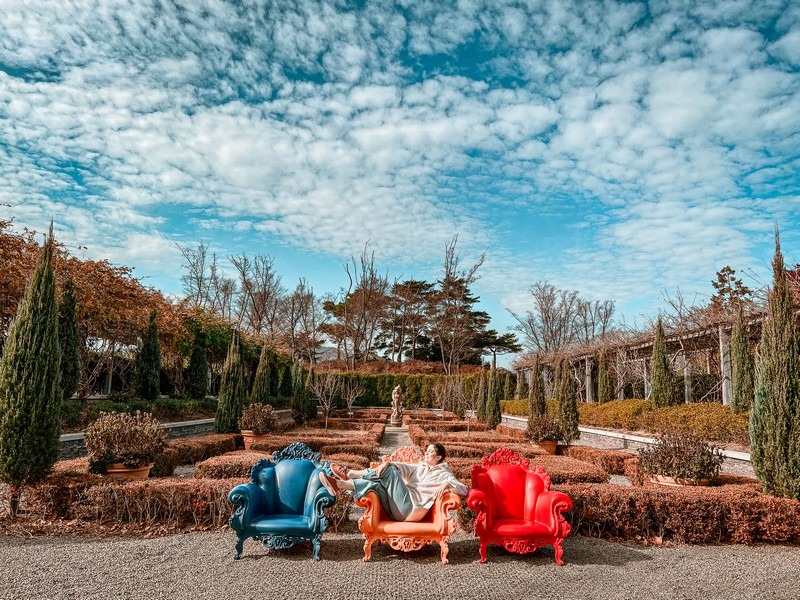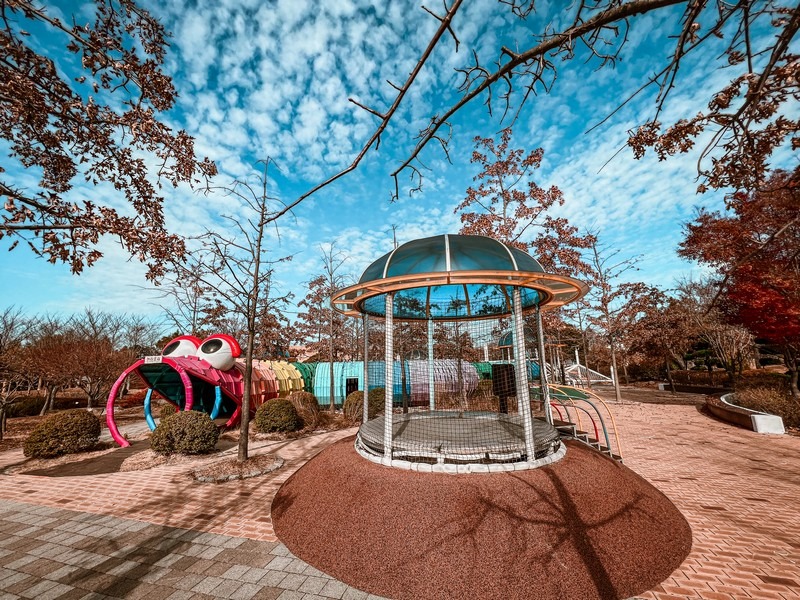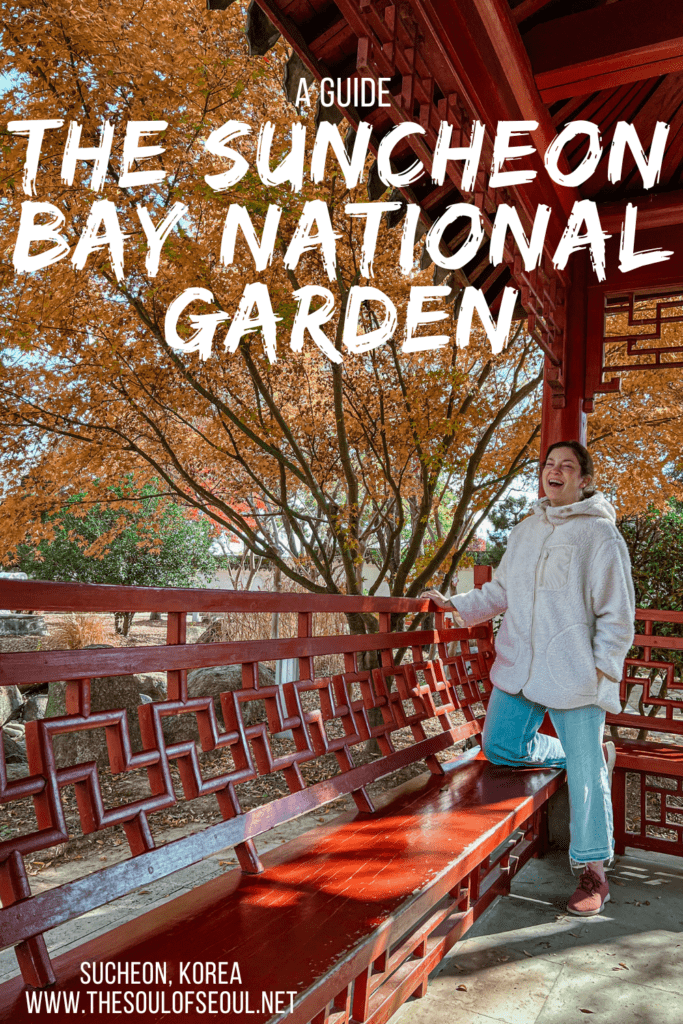Unveiling the Charm of Suncheon Bay National Garden: A Guide
Last Updated on February 12, 2024
As avid nature lovers and the sort that will travel for a beautiful natural landscape, the Suncheon Bay National Garden (순천만국가정원) was on my list of must see destinations in Korea for years. We’ve now managed to visit twice in two very different seasons and I can say without a doubt, it is one of the most beautiful and interesting natural landscapes and gardens in Korea to visit. If you’re looking to get away, look into heading to Korea’s southern coast. There is so much to explore.

Plan a trip to the gorgeous Suncheon Bay National Gardens. From spring to autumn, they are a must-see:
- How To Get There
- Basic Info
- The Stats
- Connecting The Suncheon Dots
- When To Visit
- The Garden Guide
- From East Garden to West Garden
- The West Gardens
(This post contains affiliate links, which means I receive a certain percentage of a sale if you purchase after clicking at no cost to you. Thank you for your support.)
How To Get There
Address: 47 Gukgajeongwon 1-ho gil, Suncheon-si, Jeollanam-do (전남 순천시 국가정원1호길 47)
By public transportation: Located near the Suncheon KTX Station, take a short taxi ride or a local bus 52, 66, or 200 to the West Gate. Taxis will usually take you to the East Gate entrance.
Basic Info
Hours: 9:00am ~ 6:00pm*
- During the 2023 Expo, the hours were extended so check out their website to know what the updated times are seasonally.
Closures: To protect the nature of the area and allow the gardens and reserve to recoup after a busy tourist season, the park is closed for a period of time. Be sure to check the official website to make sure it’s open when you want to go. (Can be closed throughout winter and opened again in the spring.)
Admission: Adults: W8,000; Students: W6,000; Children: W4,000

Getting around: The park is very large. We walked the entire thing, but if you have kids or people in your group with accessibility needs, there is also a small bus that can take you around to various stops. I didn’t even realize we could do that until we were more than half way through and spotted it coming around the bend.

The Stats
As the first national garden in Korea and one of the top five coastal wetlands globally, this ecological paradise spans over 1.12 million square meters, embracing 790,000 trees of 505 varieties and 3.15 million flowers across 113 types. For those who love the outdoors and want to spend as much in it as possible, Suncheon Bay National Garden is a very memorable journey.
Connecting The Suncheon Dots
A bit of info to help connect the dots if you’re like me… When I first moved to Korea in 2006, I heard so much about the Suncheonman Bay Wetland Reserve (순천만습지 or 순천만자연생태공원). It was a location touted as a must see in both the summer and the autumn. Apparently the tourism organization did such a good job promoting this region in Korea that they went from having 100,000 visitors in 2002 to more than 3 million visitors by 2010.

You can gather from the name Suncheon Bay National Garden that both of these are in the same city, at least that’s what I gathered. What I found out is that these are now two sort of entities in one park, much like how the World Cup Park in Seoul is made up of five smaller parks that each have their own name. Having come to Korea prior to the establishment of the Suncheon Bay National Garden, when I arrived and realized they were sort of one in the same, I was happily surprised.
Apparently, the number of visitors to the Suncheon Bay Wetland Reserve had become too many for it to be sustainable and in an effort to protect the area, the local government decided to create the national garden to act as a buffer area. Today, visitors from all over the world head to the gorgeous national garden and if they still have energy, they can head out to the wetland reserve. It has worked though, most people head to the gardens entirely missing the wetland reserve.
When To Visit
There are definitely different views depending on when you go. Closed during the winter, you can visit during the spring, summer, or autumn. In the spring, the gardens are filled with tulips, azaleas, and canola flowers and the fields start to transition from autumn browns to green again. In the summer, the scenery is lush and green and different parts of the gardens come alive. And in the autumn, you’ll be surprised with still more spectacular views including camellia flowers and orange and red foliage.
The Garden Guide
There are two entrances to the massive garden which could easily take you multiple days to see all of the parts of. There is the East Gate of Earth and the West Gate of Light. We entered through the the East Gate ourselves.
The East Gardens

Suncheon Lake Garden
What you see in pictures most often when it comes to the landscape of the Suncheon Bay National Garden are the spiral hills meant to represent Bonghwa and Haeryeong. Designed by world-famous landscape architect Charles Jencks, he used the city of Suncheon as his inspiration. You can see this beautiful area from the path and a blue bridge representing Dongcheon River that connects to them to allow visitors to spiral up and back down without ever crossing people going the other direction.

The World Gardens
There are various small “world gardens” representing countries from around the world. You can everything from a Chinese and Japanese garden to a Dutch garden, Turkish Garden, Italian Garden, and Spanish Garden.


The Chinese Garden: A beautiful space dedicated to The Butterfly Lovers, a well-known story set in the Chinese Eastern Jin Dynasty (265-420). The story goes that Zhu Yingtai was a smart young woman from a wealthy family but since woman weren’t allowed to be educated at that time, she dressed as a man to attend classes and there fell in love with Liang Shanbo. Unfortunately, her parents had already arranged a marriage for her and Liang, heartbroken upon hearing this news, became ill and died. On her wedding day, Zhu passed by Liang’s grave and begged to be with him and suddenly the grave opened and Zhu threw herself inside. Their spirits subsequently turned into a pair of beautiful butterflies never to be separated again.

If you want to travel the world in a day, this is the place to do it. You can find everything from British garden promenades and Italian gardens to Thai gardens too. If you have kids, this would make for a fun scavenger hunt like adventure.

Metasequoia Lane
I love sitting beneath the tower metasequoia trees, of which there seem to be many in Korea. Even in the autumn, these trees are gorgeously vibrant.


Korean Peninsula Peace Garden
At this point in our worldly journey, when I spotted these striking blue buildings that gave me JSA vibes, I was a bit surprised. Getting closer, we realized it was the Peace Garden and was built to promote unification over division. There is a pedestrian bridge, JSA-like buildings, armistice fence, peace clock, and a wall of stories which was created with the help of the Ministry of Unification. The Peace Clock, it should be noted, is meant to symbolize the peace promise created at the North-South summit in April 2018.

Wriggling Garden
I happened to take this trip with friends and sans daughter, but if you have kids, be prepared for them to want to stay in the Wriggling Garden for a fair amount of time. This colorful playground area has a long tunnel, mini trampolines, and playground equipment. After you enter from the east gate, you can either go towards this or away from this depending on how the kids feel after the trip to get there. We saw this on our way out, but you could circle back around the other day and do this first before everything I’ve mentioned above.
From East Garden to West Garden



The Dream Bridge
Created by artist Ik Joong Kang, this 175 meter long bridge is decorated with mosaic tiles with Korean characters named “Things I know”. Walk along deciphering the Hangul and you’ll come to the inside of the bridge where there are 140,000 drawings that were created by children from 16 different countries. If you want a photo to prepare for celebrating Hangul Day in Korea, this is the place to get it.
The West Gardens
While we entered through the East Gate taking us to everything mentioned above, if you park on the other side of the park, you could enter from the West Gate and see this side of the park first. This would be ideal if you want to do the Suncheon Bay Wetland Reserve earlier in the day as this is the park that you can catch the Sky Cube to get there.


The West Gardens are home to camellia flowers which bloom in the autumn and winter, an azalea garden which blooms in the spring, a bonsai garden, maple path, and sky garden. Not as large as the East Garden, it’s a bit quicker to get through these gardens.


Sky Cube Ride To The Bay
After crossing the Dream Bridge, you’ll see the large station for the Sky Cube which provides access to the Suncheon Bay Wetland Reserve. The Suncheon Bay National Garden is at the forefront of eco-friendly tourism and after building the Suncheon Bay National Garden, they created a Personal Rapid Transit (PRT) system that connects the garden with the Suncheon Culture Center.
If you are determined to get to the wetland reserve, take a ride on the Sky Cube that whisks you out over the landscape to get there. Note that once across, you’ll still need to walk more than a kilometer to get to the bay. Having visited the wetland reserve previously, we were just checking out the gardens on this trip, but this is the point in your journey that you’d want to do it.
- Admission: Because not everyone will take the Sky Cube, the cost is not included in the garden ticket price. Round trip: W8,000

The creation of Suncheon Bay National Garden was driven by a desire to protect the adjacent Suncheon Bay, an ecological marvel that faced the challenges of growing tourism. By diverting tourists to the garden, Suncheon has successfully managed to reduce the impact on the bay, showcasing a remarkable effort in ecological conservation and sustainable tourism. Are both worth the trip to the southern coast of Korea? Absolutely!
Did you like this post? Pin IT!



